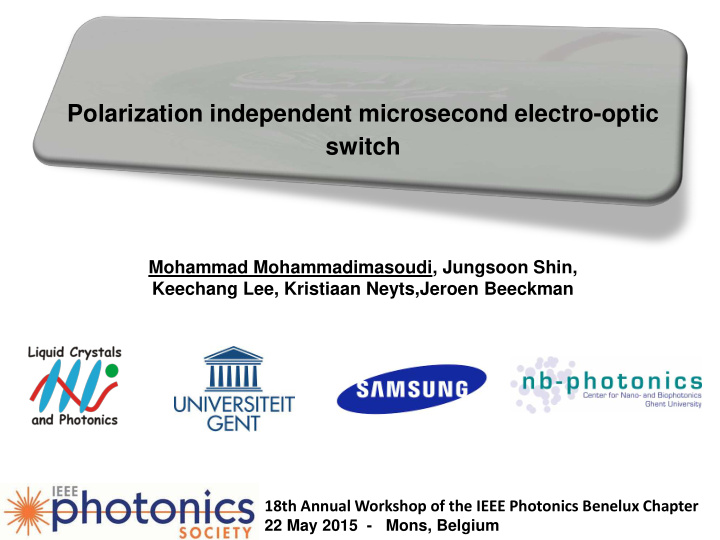



Polarization independent microsecond electro-optic switch Mohammad Mohammadimasoudi, Jungsoon Shin, Keechang Lee, Kristiaan Neyts,Jeroen Beeckman 18th Annual Workshop of the IEEE Photonics Benelux Chapter 1 of 17 Mohammad MohammadiMasoudi 22/05/2015 22 May 2015 - Mons, Belgium
Content Chiral nematic Liquid Crystals (CLCs) Photonic band gap tuning Partly Polymerized CLC Electro-optic switch 2 of 17 Mohammad MohammadiMasoudi 22/05/2015
What are CLCs? • Chiral nematic Liquid Crystals • Nematic Liquid Crystal: Anisotropic: n o & n e Large electro-optic coeff. 3 of 17 Mohammad MohammadiMasoudi 22/05/2015
Chiral nematic LC? Director direction Rotation of LC molecules like a screw 360 ° over pitch P Helix axis Refractive index change period P/2 Pitch Distributed Bragg Reflector High reflection band- photonic bandgap or PBG 4 of 17 Mohammad MohammadiMasoudi 22/05/2015
Properties of CLC • High reflection for: Pn o Pn e Pn Pn o e For circular polarized light Right handed CLC: Left handed CLC: Director direction Right handedness Helix axis ½ Pitch Left handedness Left Right 5 of 17 Mohammad MohammadiMasoudi 22/05/2015
Why PBG tuning? Important for applications: change the wavelength of transmission/reflection/lasing devices sensors diffraction gratings reflective displays tunable lasers Optical shutter Useful for photonic information technology lab-on-a-chip devices 6 of 17 Mohammad MohammadiMasoudi 22/05/2015
History Significant efforts have been devoted using external stimuli such as: Elasticity [4] Heat [1] Electricity [3] Light [2] 1-*Huang, Y. H.; Zhou, Y.; Doyle, C.; Wu, S. T. Optics Express 2006, 14 , 1236-1242 2-White, T. J.; Bricker, R. L.; Natarajan, L. V.; Tondiglia, V. P.; Bailey, C.; Green, L.; Li, Q. A.; Bunning, T. J. Opt. Commun. 2010, 283 , 3434-3436 3- Choi, S. S.; Morris, S. M.; Huck, W. T. S.; Coles, H. J. Adv. Mater. 2009, 21 , 3915 4-Finkelmann, H.; Kim, S. T.; Munoz, A.; Palffy-Muhoray, P.; Taheri, B. Adv. Mater. 2001, 13 , 1069 7 of 17 Mohammad MohammadiMasoudi 22/05/2015
History Almost all CLC devices show: slow response (~ms) small tuning range Tuning by changing the pitch Direct electronic control of the PBG is relatively hard because: Non-uniform deformation of the periodic structure Disruption of The Bragg reflection 8 of 17 Mohammad MohammadiMasoudi 22/05/2015
Our method for tuning PBG Polymerized CLC with nanopores of LC Nanopores: mixture ne, no Nanopores: only n o Pattern with mixture of reactive LC, non-reactive LC, chiral dopant and photoinitiator 9 of 17 Mohammad MohammadiMasoudi 22/05/2015
A macroscopic photograph of the device with 1 × 1 cm active region Good transmission for white light without scattering in the visible region 10 of 17 Mohammad MohammadiMasoudi 22/05/2015 which is usually not the case for polymer-CLC composites
To control the size of pores: Transmission spectra of the devices with 4 µm thickness 1- Concentration of nematic LC 2- UV dose 40 w% 50 w% • • Threshold voltage : 90 V/µm Threshold voltage : 65 V/µm • • Blue shift : 141 nm Blue shift : 114 nm 11 of 17 Mohammad MohammadiMasoudi 22/05/2015
Schematic drawing of the device operation to modulate unpolarized incident light. V L R 0% Incident light 50% 50% λ /2-plate PPCLC 1 PPCLC 2 Detector 12 of 17 Mohammad MohammadiMasoudi 22/05/2015
Transmission spectra of the device 4 µm thickness Contrast ratio: 5 13 of 17 Mohammad MohammadiMasoudi 22/05/2015
Transmission spectra of thicker device 8 µm thickness Contrast ratio: 20 14 of 17 Mohammad MohammadiMasoudi 22/05/2015
The response time Block wave electric field: 150 V/µm amplitude and 1 kHz 50 µs and 20 µs for on and off state 15 of 17 Mohammad MohammadiMasoudi 22/05/2015
Conclusions Fast (20 µs) polarization-independent optical switch wavelength range of the switching is 50 nm High stability and reflectivity No degradation or disruption Reproducible switching Easy fabrication, low cost 16 of 17 Mohammad MohammadiMasoudi 22/05/2015
Acknowledgment Jeroen Beeckman, KristiaanNeyts 17 of 17 Mohammad MohammadiMasoudi 22/05/2015
Than ank k yo you f u for or yo your ur atte tention ntion 18 of 17 Mohammad MohammadiMasoudi 22/05/2015
Recommend
More recommend